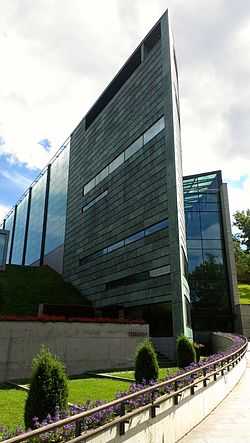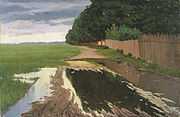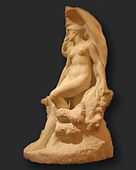Kumu (museum)
| Kumu | |
|---|---|
| Kumu Kunstimuuseum | |
|
KUMU | |
| Established | 17 February 2006 |
| Location | Weizenbergi 34 / Valge 1, Tallinn, Estonia |
| Coordinates | 59°26′11″N 24°47′47″E / 59.43639°N 24.79639°ECoordinates: 59°26′11″N 24°47′47″E / 59.43639°N 24.79639°E |
| Type | Art museum |
| Visitors | 128,712 (2013)[1][2] |
| Director | Anu Liivak |
| Public transit access |
Kumu, TLT |
| Website | www.kumu.ee |
Kumu (Estonian: Kumu Kunstimuuseum) is an art museum in Tallinn, Estonia. The museum is the largest one in the Baltics and one of the largest art museums in Northern Europe. It is one of the five branches of the Art Museum of Estonia, housing its main offices.
Kumu presents both permanent collections and temporary exhibitions. The main collection covers Estonian art from the 18th century onwards, including works from the occupations period (1940–1991) and showing both Socialist Realism and Nonconformist art. Temporary exhibitions include both foreign and Estonian modern and contemporary art.
Kumu is an abbreviation of the Estonian "Kunstimuuseum" (art museum). The designer was a Finnish architect, Pekka Vapaavuori, who won the competition in 1994. It was constructed from 2003 to 2006. The building is successfully positioned in the limestone slope of Lasnamäe Hill, and therefore, despite its size, is in harmony with the intimacy of the ancient Kadriorg Park.
Kumu received European Museum of the Year Award 2008 by European Museum Forum.[3]
Division scheme
- Ground floor: Entrance from the Kadriorg park side, auditorium and cafe.
- 1st floor: Entrance from the Lasnamägi car park side, terrace, information, cloakroom, toilets, large auditorium, library, bookstore and restaurant. Temporary exhibitions wing.
- 2nd floor: Classics of Estonian art from the 18th century until the end of the Second World War.
- 3rd floor: Estonian art from 1945 to 1991.
- 4th floor: Temporary contemporary art exhibitions, art after 1991.
History of the museum
The Art Museum of Estonia was founded on November 17, 1919, but it was not until 1921 that it got its first permanent building — the Kadriorg Palace, built in the 18th century. In 1929 the palace was expropriated from the Art Museum in order to rebuild it as the residence of the President of Estonia.
The Art Museum of Estonia was housed in several different temporary spaces, until it moved back to the palace in 1946. In September, 1991 the Kadriorg Palace was closed for renovation, since it had fallen into almost complete disrepair during the Soviet occupation of Estonia. At the end of the year the Supreme Council of the Republic of Estonia decided to guarantee the construction of a new building for the Art Museum of Estonia in Kadriorg park. Until the new building was finished, the Estonian Knighthood House at Toompea Hill in the old town of Tallinn served as the temporary main building of the Art Museum of Estonia. The exhibition there was opened on April 1, 1993. Art Museum of Estonia permanently closed down the exhibitions in that building in October 2005. In the summer of 2000 the restored Kadriorg Palace was opened, but not as the main building of the Art Museum of Estonia, but as a branch. Kadriorg Art Museum now exhibits the foreign art collection of the Art Museum of Estonia.
For the first time in its nearly 100-year-old history, the Art Museum of Estonia now has a building that both meets the museum's requirements and is worthy of the Estonian art in its collections. Kumu includes exhibition halls, an auditorium that offers diverse possibilities, and an education centre for children and art lovers (see above). KUMU has a thorough collection of Estonian art, including paintings by Carl Timoleon von Neff, Oscar Hoffmann, Ants Laikmaa, Julia Hagen-Schwarz, Oskar Kallis, Konrad Mägi, Jaan Koort, Henn Roode and Johannes Greenberg.
From the collections
|
See also
- Art Museum of Estonia (other branches of the museum)
References
- ↑ "Enneolematu muuseumimenu: Titanicu näitusel on käinud 200 000 inimest". epl.delfi.ee (in Estonian) (Eesti Päevaleht). 26 March 2014. Retrieved 29 January 2015.
- ↑ "Kultuuriministeeriumi haldusala muuseumide külastatavus 2013" (PDF) (in Estonian). Kultuuriministeerium. Retrieved 30 January 2015.
- ↑ European Museum Forum.
External links
| Wikimedia Commons has media related to Kumu (museum). |
| ||||||||||||||||||||||||||||||||||||||||||||||||




